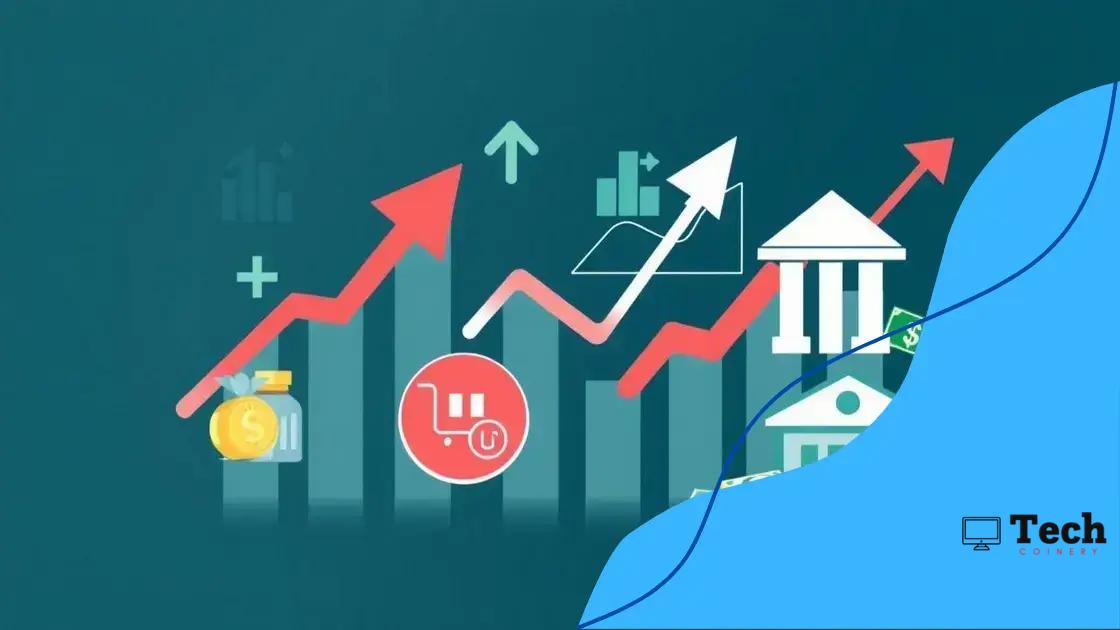Federal Reserve rate cut speculation: what it means for you

Federal Reserve rate cut speculation affects consumer spending by making borrowing cheaper, encouraging purchases and economic growth while requiring consumers to stay informed and manage their finances wisely.
Federal Reserve rate cut speculation has been a hot topic lately. But what does it really mean for your finances? With potential changes on the horizon, understanding these implications is crucial.
Understanding the Federal Reserve’s role
Understanding the Federal Reserve’s role is crucial for anyone interested in how the economy functions. This central bank isn’t just a distant authority; it plays a significant part in shaping our financial landscape.
The Federal Reserve has several key responsibilities, including regulating banks, controlling inflation, and managing interest rates. These functions help to maintain economic stability. Let’s delve into these roles further.
Key Responsibilities of the Federal Reserve
Some of the main tasks of the Federal Reserve include:
- Monitoring and regulating the banking system
- Setting and adjusting interest rates to influence economic activity
- Managing inflation and employment levels
- Providing financial services to the government
The Federal Reserve also conducts monetary policy, which involves adjusting interest rates based on economic conditions. When the economy is sluggish, the Fed may lower rates to encourage borrowing and spending. Conversely, if inflation rises, it might increase rates to cool off borrowing.
Inflation Control Measures
Inflation control is one of the Federal Reserve’s most critical jobs. By monitoring the economy, the Fed aims to keep inflation at a manageable level. A stable economy benefits consumers and businesses alike.
When inflation rises too quickly, it can reduce purchasing power, making it essential for the Federal Reserve to act quickly. They use tools like interest rate adjustments to help keep inflation in check.
In summary, the Federal Reserve is more than just a regulatory body; it’s a vital part of our economic system. By understanding its role, you can better prepare for how its actions may impact your financial decisions.
Recent trends in rate cut speculation
Recent trends in rate cut speculation have gained attention in the financial world. This activity is largely driven by various economic indicators that hint at future moves by the Federal Reserve. Understanding these trends can provide insights into potential shifts in interest rates that may affect many aspects of the economy.
Market analysts closely watch data such as inflation rates, employment statistics, and consumer spending trends. These factors can significantly influence speculation around rate cuts. When inflation is low or employment rates drop, discussions about possible rate cuts become more prominent.
Impact of Economic Indicators
Here are some key indicators that affect rate cut speculation:
- Inflation Rates: Higher inflation may lead to increased rates, while lower inflation can prompt speculation about cuts.
- Employment Trends: A rise in unemployment often signals a need for rate cuts to stimulate growth.
- Consumer Spending: Decreased spending might push the Fed towards lowering rates to encourage economic activity.
- Global Economic Conditions: International market trends can also influence domestic rate speculation.
Recently, there has been a notable shift in how the market responds to these indicators. For instance, slight fluctuations in inflation rates have caused immediate reactions in stock prices and bond yields, reflecting how interconnected these elements are.
The Fed’s Statements
Statements from Federal Reserve officials play a crucial role too. Dovish comments often fuel rate cut speculation, while hawkish tones can temper it. Investors pay close attention to these remarks as they can steer market expectations significantly.
In this environment, remaining informed about these trends and the factors that drive them can help in making better financial decisions. The narrative around rate cuts continues to evolve, and understanding this evolution is key for consumers and investors alike.
Potential impacts on the economy

The potential impacts on the economy due to changes in interest rates are significant. When the Federal Reserve considers rate cuts, it can lead to various effects that ripple through different sectors. Understanding these impacts helps consumers and businesses prepare for potential changes in the economic landscape.
One major area affected by rate cuts is consumer borrowing. Lower interest rates often lead to cheaper loans for purchasing homes, cars, and other consumer goods. This can boost spending and stimulate economic growth. Additionally, businesses may find it more affordable to finance expansions or new projects, promoting job creation.
Effects on Different Economic Sectors
Several sectors of the economy can see notable changes when the Fed lowers rates:
- Housing Market: Lower rates can make mortgages more accessible, driving home sales and increasing property values.
- Consumer Behavior: With lower loan costs, consumers may increase spending on goods and services.
- Investment Opportunities: Businesses may have more capital to invest in growth, benefiting job markets.
- Stock Market: Rate cuts can lead to higher stock prices as investors seek better returns, affecting overall market confidence.
However, the impacts are not universally positive. Prolonged low rates can lead to higher inflation if demand outstrips supply. This can erode purchasing power, making goods and services more expensive. Additionally, if rates are cut too frequently or extensively, it can lead to asset bubbles where prices rise beyond sustainable levels.
Long-term Implications
Understanding the long-term implications of rate cuts is vital for both consumers and investors. If the economy overheats due to excessive borrowing, the Fed may eventually need to increase rates sharply to stabilize it. This could lead to sudden shocks in the economy and may catch many off guard.
In essence, the Federal Reserve’s decisions regarding rates hold immense weight. Staying informed about these potential impacts aids individuals and businesses in adapting to an ever-changing economic environment.
How rate cuts affect consumer spending
How rate cuts affect consumer spending is a crucial topic in understanding economic dynamics. When interest rates decrease, borrowing becomes cheaper, encouraging consumers to take loans for big purchases. This can lead to an overall increase in spending across various sectors.
For example, lower mortgage rates enable more people to buy homes or refinance existing loans. This stimulates not just the housing market but also associated sectors like home improvement, furniture, and appliances. Similarly, with lower auto loan rates, consumers may opt for new cars, boosting the automotive industry.
Direct Impacts of Rate Cuts
Here are some direct impacts of rate cuts on consumer behavior:
- Increased Borrowing: Consumers are more likely to take out loans for major purchases.
- Higher Consumer Confidence: Cheaper borrowing costs can lead to greater confidence in spending.
- Boost in Retail Sales: As spending increases, retail sales often go up, benefitting the economy.
- Potential for Inflation: Increased demand may eventually lead to inflation if supply does not keep pace.
Moreover, when consumers can afford to spend more, it creates a positive feedback loop. Businesses see increased sales and may hire more staff or invest in expansion, which further improves the economy. This relationship highlights the importance of rate cuts in driving economic growth.
Long-term Considerations
While rate cuts can stimulate spending in the short term, it’s essential to consider potential long-term effects. Sustained low rates may lead to excessive borrowing and higher debt levels. If consumers become over-leveraged, it can pose risks to financial stability and slow future economic growth.
In conclusion, understanding how rate cuts affect consumer spending helps consumers and businesses navigate the economic landscape. Awareness of these dynamics is vital for making informed financial decisions.
Tips for consumers during uncertain times
During uncertain times, it’s crucial for consumers to be prepared and informed. Rate cuts can lead to various economic shifts that impact personal finance. By adopting smart strategies, consumers can safeguard their financial well-being.
One important tip is to keep track of changes in interest rates. Understanding when rates drop can help consumers make informed decisions about loans and mortgages. Additionally, paying attention to economic news can provide insights into potential future rate cuts and market trends.
Practical Tips for Managing Finances
Here are some practical tips for consumers:
- Maintain an Emergency Fund: Having savings set aside for emergencies can provide a safety net during unstable times.
- Evaluate Loan Options: If rates are low, consider refinancing existing loans for better terms.
- Reduce Unnecessary Expenses: Cutting back on non-essential spending can help improve financial flexibility.
- Invest Wisely: Explore investment options that align with risk tolerance, especially with changing interest rates.
Another key area to focus on is budgeting. Creating a clear budget can help track spending and ensure that essential expenses are covered. It’s also wise to be cautious with new purchases, especially big-ticket items, in case financial conditions worsen.
Stay Informed and Flexible
Staying informed about economic indicators and the Federal Reserve’s actions can empower consumers. Being flexible and adapting to changing circumstances is vital. If additional rate cuts are anticipated, consumers may decide to make purchases sooner rather than later, particularly for loans that benefit from lower rates.
In these unpredictable times, maintaining a proactive approach to finances allows consumers to navigate challenges better and seize opportunities as they arise.
FAQ – Frequently Asked Questions about Federal Reserve Rate Cuts and Consumer Spending
How do rate cuts affect my mortgage?
Rate cuts generally lead to lower mortgage rates, which can make refinancing or obtaining a new mortgage more affordable.
What should I do if I have existing loans when rates drop?
Consider refinancing your loans, as lower interest rates can lead to reduced monthly payments and overall interest costs.
How can I prepare for potential economic changes due to rate cuts?
Stay informed about economic indicators, maintain an emergency fund, and create a budget to manage your finances effectively.
Will consumer spending increase with rate cuts?
Yes, lower interest rates often boost consumer spending as borrowing becomes cheaper, encouraging purchases of homes, cars, and other goods.






